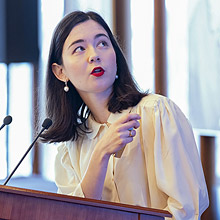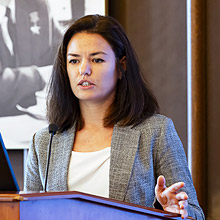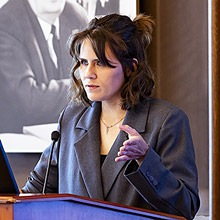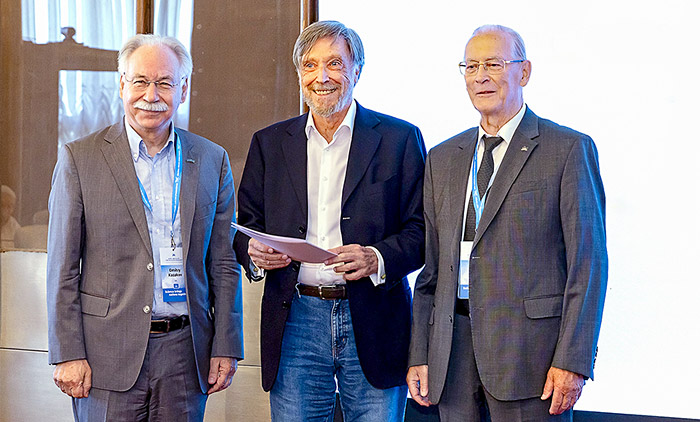
Electronic english version since 2022 |
The newspaper was founded in November 1957
| |
At the 136th session of the JINR Scientific Council
Excellent results, new partners, numerous awards
On 12-13 September, the 136th session of the JINR Scientific Council was held in the JINR International Conference Centre. The results and plans, new proposals were discussed, elections were held and decisions on awarding prizes were announced.
JINR Director, Academician of the Russian Academy of Sciences Grigory Trubnikov presented a detailed report on the current state of affairs. The report covered the decisions of the March meeting of the Committee of Plenipotentiaries, the results of the implementation of the Seven-Year Plan for the Development of JINR in 2024-2030, the progress of projects included in the Topical Plan for 2024, as well as events in the scientific and international activities of JINR.
In his report, Grigory Trubnikov recalled that on 13 June, during his visit to JINR, President of Russia Vladimir Putin visited the NICA accelerator complex and launched the technological start-up of the collider. This important stage in the implementation of the NICA mega-science project marks the beginning of preparations for commissioning and launching the experimental programme.
A significant part of the report was dedicated to scientific results and plans for the near future. Technological tests of the NICA collider ring, installation of cryogenic equipment, assembly of power plants, construction of the collider building, connection of power transmission lines and energy evacuation systems are underway. The MPD solenoid has been successfully cooled to a temperature of 72 K, preparations for the analysis of the first data sets of the experiment scheduled for August 2025 are currently carried out. The technical design of the TDR for SPD has been finalized and approved, prototypes of detectors are developed. Development of the ARIADNA collaboration and its research programme is highlighted, preparations are underway for the biosatellite experiment scheduled for 2025. The progress of the analysis of experimental data in Xe + CsI reactions obtained in the BM@N session is presented.

Taking into account the 2024 expeditions under the Baikal-GVD project, a total of 4104 optical modules have been installed, 13 complete clusters currently operate and the coastal infrastructure has been significantly improved. In 2025, it is scheduled to assemble about 700 more modules.
Experiments at the Superheavy Element Factory are implemented successfully, primarily aimed at preparing experiments on the synthesis of elements 119 and 120 using 54Cr and 50Ti beams. The experimentally known area of the nuclear map has been expanded due to the discovered isotopes 288Lv, 289Lv. The first experiment on isotopes of the element 114 is scheduled for autumn 2024. The modernization of the U 400M accelerator has been completed, work is underway to reach the design parameters of the accelerator and preparations for the first experiments are carried out. Rapid progress has been noted in the construction of the new U-400R experimental hall and the completion of the gallery from the U-400 cyclotron hall to the new experimental hall.
Preparatory work is underway at the Frank Laboratory of Neutron Physics to launch the IBR-2 reactor after a long period of shutdown. A license for reactor operation has been obtained from the regulatory authority, one of the two air heat exchangers has been replaced and the second one is currently replaced. The technical readiness of the IBR-2 reactor for launch is scheduled for November. Experimental work on external beams is scheduled for spring 2025. Director of the Institute also highlighted the significant results of fundamental and applied research in materials science and ecology carried out at the Frank Laboratory of Neutron Physics, as well as in the field of life sciences thanks to the development of an interlaboratory research programme, in particular, in the Laboratory of Radiation Biology.
Interesting theoretical results have been achieved in the physics of elementary particles, atomic nuclei, condensed matter physics and mathematical physics, aimed, in particular, at supporting the JINR experimental programme. The operation and development of the JINR Multifunctional Information and Computing Complex have been successful, including increasing the capacity of the Govorun supercomputer, expanding the functions of the JINR grid nodes by including their resources in the system of simulating, processing and storing data from the BM@N, MPD and SPD experiments, increasing the capacity of the tape storage from 50 PB to 90 PB and assigning the JINR Tier1 centre the first place among the world's Tier1 centres for the CMS experiment in terms of processor time for data processing.
The 70th anniversary of scientific cooperation between CERN and JINR that officially started in 1957 and was officially registered in 1963 was especially highlighted. Namely, the CERN-JINR schools for young scientists, the scientific contribution of the Institute to the general activities of CERN, to the development of the LHC and the CMS, ATLAS and ALICE experiments, to the WLCG, to programmes not related to the Large Hadron Collider: COMPASS, NA48, NA49, NA61, NA62 and OPERA. Since 2014, JINR has had observer status in the CERN Council. The bilateral agreement between JINR and CERN has been extended for the next five years. JINR extensively works on the second stage of the ALICE, ATLAS and CMS modernization programme.
Grigory Trubnikov highlighted the efficient participation of the JINR group in the first phase of the COMET experiment in J-PARC.
Director's report included figures on the publication activity of employees, age distribution, participation in student practices, schools for physics teachers, schools and conferences for young scientists. International cooperation was described in detail - mutual visits, signing of cooperation agreements, participation in scientific forums. The MSU branch welcomed students to the first year of the master's programme. Since 1 September, 2019, 102 theses have been defended in JINR dissertation councils, including 80 candidate and 22 doctoral theses.
In general, the Committee of Plenipotentiaries emphasized the high efficiency of the Institute's activities in enhancing and expanding scientific cooperation with partner organizations of the JINR Member States and Associate Members, increasing the level of cooperation with China, Mexico, Brazil and India. The Committee of Plenipotentiaries supported Directorate's efforts to update and develop the social infrastructure of JINR and to develop an international innovation park of science and technology in Dubna, including the construction of an advanced university campus and the integrated development of adjacent territories. The Committee of Plenipotentiaries also supported JINR Directorate's initiative of a new scientific journal to be published by JINR.
In conclusion, Grigory Trubnikov answered questions about the upcoming MPD experiment, the possibility of resuming the CERN-JINR schools for young scientists, the participation of young scientists in JINR schools, the commitments under the FAIR (GSI) project, as well as the opportunities and obstacles to expanding international cooperation.
The members of the Scientific Council stated with great satisfaction the successful implementation of the current Seven-Year Plan for the Development of JINR, significant results in scientific research and the development of research infrastructure, as well as the positive dynamics of all important indicators.
The session of the Scientific Council was chaired by Academician of the National Academy of Sciences of Belarus Sergey Kilin. Two years ago, in an interview with the JINR Press Office, he mentioned that "this is exactly how scientific organizations should act in the period we experience. And JINR sets a good example for us." When asked by a correspondent whether his attitude had changed, he replied: "My opinion has not changed, I would say it has become more confident in what I said earlier, for we can see a very rapid, operational change concerning the current situation, the actions of Directorate and all employees. This is the only way to fulfill all the obligations that the Institute has taken on. It is clear to everyone that it is impossible to do it traditionally, as was done before. Yet, it is absolutely necessary to do it. You can't groan or sigh, you need to turn on your intuition, intellect and meet these problems. There is no other way." Sergey Kilin was especially delighted by the strengthening of cooperation with new countries - Mexico, the BRICS countries, China, Southeast Africa. "It is impossible to say that this is one action," he noted, "the work is currently carried out in different areas. There is a response, I see it today on the screen. People that doubted at the beginning, at present, even wish to help with their advice. It also means a lot."
The recommendations of the June meetings of the PACs, the memberships of the PACs and the adoption of the Topical Plan for 2025 were discussed afterwards. At the suggestion of JINR Director Grigory Trubnikov, the Scientific Council appointed Amaresh Jaiswal (NISER, Bhubaneswar, India), Leandar Litov (Sofia University "St. Kliment Ohridski", Bulgaria), Gobinda Majumder (TIFR, Mumbai, India) as members of the PAC for Particle Physics for a term of three years and Ravi Kumar N.V. (IIT Madras, Chennai, India) as a member of the PAC for Condensed Matter Physics for a term of three years.
In the scientific report "Search for quark-gluon plasma at the Large Hadron Collider: what's next?" Raghunath Sahoo (IIT Indore, India) presented an overview of the research of Indian scientists in the field of relativistic heavy ions within the framework of their participation in the experimental programme of the Large Hadron Collider.
With interest and subsequent wish to continue the initiative, the members of the Scientific Council listened to the reports of young scientists selected by the PAC for this session. In the report "The investigation of the Λ-hyperon production in carbon collisions with solid targets in the BM@N experiment" Kseniya Alishina (VBLHEP) spoke about the processing of the first data obtained in carbon-nucleus collisions with kinetic energies of the beam of 4.0 and 4.5 GeV/nucleon with Al, C, Cu and Pb targets. The methodology for measuring the cross section and yields of the Λ-hyperon in the Λ→p+ϖ- decay channel was presented, as well as the results of the analysis of the inverse distributions of transverse impulses.
In the report "Real-time tracking of multi-channel alerts using the Baikal GVD telescope" Viktoriya Dik (DLNP) reported that at the beginning of 2021, an automatic data processing and alert generation system was launched on Baikal, classifying neutrino events into "muon neutrinos" and "neutrinos of all types". One of the significant results of this tracking is the temporal and spatial correlation of the Baikal GVD cascade event GVD211208CA with an energy of 43 TeV and the alert for the muon neutrino IceCube211208A that is possibly related to the blazar PKS0735+178.
The third report was on "The effect of pressure on the crystal, magnetic structure and vibrational properties of van der Waals materials" by Olga Lis (Leningrad Nuclear Physics Laboratory). It was shown that high pressure results in the transformation of the initial quasi-two-dimensional structure of CrBr3 into a three-dimensional one, as well as in a possible magnetic transition. The observed structural transformation in CrCl3 at high pressures also results in a change in the nature of magnetic interactions. These and subsequent results can significantly deepen the understanding of the observed physical phenomena that also manifest themselves in other van der Waals magnets and contribute to the development of theoretical models to explain these effects.
 |
 |
 |
| Viktoriya Dik | Olga Lis | Kseniya Alishina |
The unit of messages dedicated to decisions on awarding JINR prizes was rich and positively received by those present.
Thus, the jury's recommendations on awarding were approved:
- Dzhelepov Prize to Marina Frontasyeva (FLNP) for significant contribution to the development of an international programme for estimating air quality using neutron activation analysis;
- Flerov Prize to Academician Rady Ilkaev (VNIIEF), co-author of the discovery of element 114, for his major contribution to the synthesis and investigation of the properties of superheavy nuclei, as well as to a team of scientists: E.D.Donets and E.E.Donets (VBLHEP), Zhao Hongwei (Institute of Modern Physics, Chinese Academy of Sciences) for the development of sources of highly charged ions to obtain intense accelerated beams of average and high power;
- Bogolyubov Prize to Alvaro de Rujula (CERN) and Ivan Todorov (BAS) for outstanding achievements in the field of theoretical and mathematical physics and promotion of international cooperation.

Dmitry Kazakov, Alvaro de Rujula and Victor Matveev
Alvaro de Rujula's responding was described as brilliant, uniting theoretical ideas with a story about working with outstanding theorists from Dubna and historical photographs were shown.
BLTP Director Dmitry Kazakov stated that the Bogolyubov Prize is always awarded to unusual people, but this time, especially: "Ivan Todorov is not just a famous Bulgarian scientist, academician and so forth. He has worked in Dubna for many years. These were the 1960s, theorists worked on what was then "fashion" and wrote a book that became very famous - N.N.Bogolyubov, A.A.Logunov, I.T.Todorov "Fundamentals of the axiomatic approach to field theory". And he is one of the patriarchs of this book. I.T.Todorov is closely united with Dubna, personally, with N. N. Bogolyubov. Therefore, everything is symbolic - this year, Nikolay Bogolyubov turns 115 and his direct student will soon celebrate his 90th jubilee. Unfortunately, he could not come.
The second winner, Alvaro de Rujula, a very famous physicist, has visited JINR many times. I remember him very well, starting from 1976, when he, still a relatively young man, gave a report at the Rochester Conference in Tbilisi. He had a significant report, he is an artistic person. At that time, the fourth quark had just been discovered, all this was discussed, he presented a beautiful picture with quarks and we then issued badges, they still hang in my office. He was on very good terms with V.G. Kadyshevsky and has visited Dubna many times. He has worked in the USA, at CERN he has been Head of the Theoretical Department. He has published a lot of papers, as he himself has noted, 17 papers have been implemented with Nobel winners."
The winners of the OGANESSON International Prize in 2024 have been announced. They are: Director of the Institute for Cognitive Studies at St. Petersburg State University (Russia) Tatyana Chernigovskaya, a senior researcher at the Flerov Laboratory of Nuclear Reactions at JINR Galina Knyazheva, Head of the Laboratory of Research and Innovation System (NURIS) at Nazarbayev University (Kazakhstan) Aliya Nurmukhanbetova, Vice-Chancellor and Rector of the University of the Witwatersrand (South Africa) Zeblon Vilakazi, Academician of the Russian Academy of Sciences, a chief researcher at the Department of Analytical Chemistry at Moscow State University, a chief researcher at the Institute of General and Inorganic Chemistry (Russia) Yury Zolotov.
JINR Director Grigory Trubnikov presented diplomas to the winners of the annual JINR awards for the best scientific, methodological and applied research. The members of the Scientific Council congratulated the winners.
Alexander Bugay was elected Director of the Laboratory of Radiation Biology (LRB) for a second five-year term. Vacancies for Deputy Directors of LRB were also announced. The appointments will be approved at the 137th session of the Scientific Council in February 2025.
Galina MYALKOVSKAYA,
photo by Elena PUZYNINA